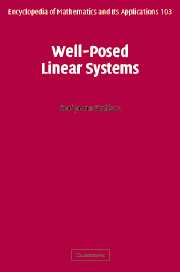Book contents
- Frontmatter
- Contents
- List of figures
- Preface
- List of notation
- 1 Introduction and overview
- 2 Basic properties of well-posed linear systems
- 3 Strongly continuous semigroups
- 4 The generators of a well-posed linear system
- 5 Compatible and regular systems
- 6 Anti-causal, dual, and inverted systems
- 7 Feedback
- 8 Stabilization and detection
- 9 Realizations
- 10 Admissibility
- 11 Passive and conservative scattering systems
- 12 Discrete time systems
- Appendix
- Bibliography
- Index
6 - Anti-causal, dual, and inverted systems
Published online by Cambridge University Press: 13 October 2009
- Frontmatter
- Contents
- List of figures
- Preface
- List of notation
- 1 Introduction and overview
- 2 Basic properties of well-posed linear systems
- 3 Strongly continuous semigroups
- 4 The generators of a well-posed linear system
- 5 Compatible and regular systems
- 6 Anti-causal, dual, and inverted systems
- 7 Feedback
- 8 Stabilization and detection
- 9 Realizations
- 10 Admissibility
- 11 Passive and conservative scattering systems
- 12 Discrete time systems
- Appendix
- Bibliography
- Index
Summary
In this chapter we introduce various transformations on a system. An anti-causal system evolves in the backward time direction. To get the flow-inverted system we interchange the roles of the input and the output. Time-inversion means that we reverse the direction of time. To get a time-flow-inverted system we perform both of these transformations at the same time. Both well-posed and non-well-posed versions of these transformations are given.
Anti-causal systems
Up to now we have only considered causal systems which are well-posed in the forward time direction, i.e., we have always chosen the initial time to be smaller than the final time. It is possible to develop a completely analogous theory for anti-causal systems which are well-posed in the backward time direction. These systems appear naturally, e.g., when we want to pass from a system to its dual.
To get an anti-causal system it suffices to take a causal system and reverse the time direction as follows.
Definition 6.1.1 Let U, X, and Y be Banach spaces, and let 1 ≤ p ≤ ∞. An anti-causal Lp∣Reg-well-posed linear system Σ on (Y, X, U) consists of a quadruple Σ = satisfying the following conditions:
operator family = ચ-t, t ≥ 0, is a C0 semigroup on X;
B: Lp∣Regc(U) → X satisfies ચsBu = Bτsπ+u for all u ∈ Lp∣Regc(U) and all s ≤ 0;
ℭ: X → Lp∣Regloc(ℝ-; Y) satisfies ℭચsx = π-τsℭx for all x ∈ X and all s ≤ 0;
D: Lp∣Regloc, c(ℝ; U) → lp…
- Type
- Chapter
- Information
- Well-Posed Linear Systems , pp. 332 - 402Publisher: Cambridge University PressPrint publication year: 2005



